#simone baudouin
Text
Famous Five Art Nostalgia – Masterpost
Click below for an easy way to navigate through my "Famous Five Art Nostalgia" posts!

Introductory post
ORIGINAL SERIES BY ENID BLYTON:
Publishing overview
📜🏰🪙 #01 Five on a Treasure Island / Le Club des Cinq et le trésor de l’île
Part 1: illustrations by Jeanne Hives (1962) + cover art
Part 2: illustrations by Jean Sidobre (1983)
Part 3: illustrations by Umberto Nonna (1982)
Part 4A and Part 4B: illustrations by Jean Sidobre – Vermeille (1971)
☃️🎄🔦 #02 Five Go Adventuring Again / Le Club des Cinq
Part 1: illustrations by Simone Baudouin (1961) + cover art
Part 2: illustrations by Jean Sidobre (1982)
Part 3: illustrations by Umberto Nonna (1981)
Part 4A and Part 4B: illustrations by Jean Sidobre – Galaxie (1975)
🛶🥫👒 #03 Five Run Away Together / Le Club des Cinq contre-attaque
Cover art
Part 1: illustrations by Simone Baudouin (1955)
Part 2: illustrations by Jean Sidobre (1976)
Part 3: illustrations by Umberto Nonna (1981)
Part 4: illustrations by Annie-Claude Martin (1984)
⛰️🧺🌫️ #04 Five Go to Smuggler’s Top / Le Club des Cinq en vacances
Part 1: illustrations by Simone Baudouin (1963) + cover art
Part 2: illustrations by Jean Sidobre (1973)
Part 3: illustrations by Umberto Nonna (1981)
Part 4A and Part 4B: illustrations by Jean Sidobre – Vermeille - COMING SOON!
🎪🐵👑 #05 Five Go Off in a Caravan / Le Club des Cinq et les saltimbanques
Part 1: illustrations by Jeanne Hives (1965) + cover art
Part 2: illustrations by Jean Sidobre (1976)
🧣🔭⚗️ #06 Five On Kirrin Island Again / Le Club des Cinq joue et gagne
Part 1: illustrations by Simone Baudouin (1956) + cover art
Part 2: illustrations by Umberto Nonna (1981)
Part 3: illustrations by Jean Sidobre (1975)
🏕️🚞👻 #07 Five Go Off to Camp / Le Club des Cinq va camper
Part 1: illustrations by Paul Durand (1957) + cover art
Part 2: illustrations by Umberto Nonna (1982)
Part 3: illustrations by Jean Sidobre (1977)
🚲🦉🚪 #08 Five Get into Trouble / Le Club des Cinq en péril
Part 1: illustrations by Jeanne Hives (1969) + cover art
Part 2: illustrations by Jeanne Hives – Idéal-Bibliothèque (1962)
Part 3: illustrations by Simone Baudouin (1957)
Part 4: illustrations by Umberto Nonna (1981)
Part 5: illustrations by Jean Sidobre (1979)
🍒🌲⛵ #09 Five Fall into Adventure / Le Club des Cinq et les gitans
Part 1: illustrations by Jeanne Hives (1960) + cover art
Part 2: illustrations by Jean Sidobre (1973)
Part 3: illustrations by Umberto Nonna (1982)
Part 4A and Part 4B: illustrations by Jean Sidobre – Vermeille (1975) - COMING SOON!
🍂🥾🏞️ #10 Five on a Hike Together / Le Club des Cinq en randonnée
Part 1: illustrations by Simone Baudouin (1958) + cover art
Part 2: illustrations by Umberto Nonna (1981)
Part 3: illustrations by Jean Sidobre (1976)
📰👀🐍 #11 Five Have a Wonderful Time / Le Club des Cinq en roulotte
Part 1: illustrations by Jeanne Hives (1960) + cover art
Part 2: illustrations by Jean Sidobre (1974)
Part 3: illustrations by Umberto Nonna (1981)
🌊🏖️🐴 #12 Five Go Down to the Sea / Le Club des Cinq au bord de la mer
Part 1: illustrations by Aldo de Amicis (1959) + cover art
Part 2: illustrations by Umberto Nonna (1981)
Part 3: illustrations by Jean Sidobre (1984)
🐎😶🌫️🚂 #13 Five Go to Mystery Moor / La locomotive du Club des Cinq
Part 1: illustrations by Jeanne Hives (1961) + cover art
Part 2: illustrations by Umberto Nonna (1981)
Part 3: illustrations by Jean Sidobre (1987)
🐩⛱️🎡 #14 Five Have Plenty of Fun / Enlèvement au Club des Cinq
Part 1: illustrations by Jeanne Hives (1961) + cover art
Part 2: illustrations by Jean Sidobre (1983)
Part 3: illustrations by Umberto Nonna (1981)
🏚️🏺💼 #15 Five on a Secret Trail / Le Club des Cinq se distingue
Part 1: illustrations by Jeanne Hives (1968) + cover art
Part 2: illustrations by Jeanne Hives – Idéal-Bibliothèque (1961)
Part 3: illustrations by Jean Sidobre (1977)
Part 4: illustrations by Umberto Nonna (1981)
🛩️🦋🐷 #16 Five Go to Billycock Hill / Le Club des Cinq et les papillons
Part 1: illustrations by Jeanne Hives (1962) + cover art
Part 2: illustrations by Umberto Nonna (1981)
Part 3: illustrations by Jean Sidobre (1983)
❄️🛷⛷️ #17 Five Get into a Fix / Le Club des Cinq aux sports d’hiver
Part 1: illustrations by Jeanne Hives (1964) + cover art
Part 2: illustrations by Jean Sidobre (1978)
Part 3: illustrations by Umberto Nonna (1981)
Part 4A and Part 4B: illustrations by Jean Sidobre – Vermeille (1975)
⛏️💎🗡️ #18 Five on Finniston Farm / Le Club des Cinq et le coffre aux merveilles
Part 1: illustrations by Jeanne Hives (1962) + cover art
Part 2: illustrations by Jean Sidobre (1979)
Part 3: illustrations by Umberto Nonna (1981)
Part 4A and Part 4B: illustrations by Jean Sidobre – Vermeille (1973)
🧭🐒🔔 #19 Five Go To Demon’s Rocks / La boussole du Club des Cinq
Part 1: illustrations by Jeanne Hives (1963) + cover art
Part 2: illustrations by Jean Sidobre (1975)
Part 3: illustrations by Umberto Nonna (1981)
⛳ 🪣🌬️ #20 Five Have a Mystery to Solve / Le Club des Cinq et le secret du vieux puits
Part 1: illustrations by Jeanne Hives (1966) + cover art
Part 2: illustrations by Jean Sidobre (1978)
Part 3: illustrations by Umberto Nonna (1982)
🙊📓🕰️ #21 Five Are Together Again / Le Club des Cinq en embuscade
Part 1: illustrations by Jeanne Hives (1967) + cover art
Part 2: illustrations by Jean Sidobre (1981)
Part 3: illustrations by Umberto Nonna (1981)
Part 4: illustrations by Jean Sidobre – Vermeille (1973)
~~~~~~
CONTINUATION SERIES ‘LES CINQ’ BY CLAUDE VOILIER:
Introduction to ‘Les Cinq’
👁️🐓✉️ #LC01 Les Cinq sont les plus forts / The Famous Five and the Mystery of the Emeralds
Part 1: illustrations by Jean Sidobre (1971) + cover art
Part 2: illustrations by Anne Bozellec (1991)
🏞️🎊💼 #LC02 Les Cinq au bal des espions / The Famous Five in the Fancy Dress
Part 1: illustrations by Jean Sidobre (1971)
Part 2: illustrations by Anne Bozellec (1993)
🚴🏰⌚ #LC03 Le marquis appelle les Cinq / The Famous Five and the Stately Homes Gang
Part 1: illustrations by Jean Sidobre (1972)
🐆🐕🐒 #LC04 Les Cinq au Cap des Tempêtes / The Famous Five and the Missing Cheetah
Part 1: illustrations by Jean Sidobre (1972)
🌴🎥🛳️ #LC05 Les Cinq à la télévision / The Famous Five Go on Television
Part 1: illustrations by Jean Sidobre (1973)
Part 2: illustrations by Anne Bozellec (1995)
✈️🛖🪶 #LC06 Les Cinq et les pirates du ciel / The Famous Five and the Hijackers
Part 1: illustrations by Jean Sidobre (1973)
🚢🪄💍 #LC07 Les Cinq contre le Masque Noir / The Famous Five versus the Black Mask
Part 1: illustrations by Jean Sidobre (1974)
🤿🦈🪙 #LC08 Les Cinq et le galion d'or / The Famous Five and the Golden Galleon
Part 1: illustrations by Jean Sidobre (1974)
📦🛻💎 #LC09 Les Cinq font de la brocante / The Famous Five and the Inca God
Part 1: illustrations by Jean Sidobre (1975)
🧺🚇🦪 #LC10 Les Cinq se mettent en quatre / The Famous Five and the Pink Pearls
Part 1: illustrations by Jean Sidobre (1975)
Part 2: illustrations by Anne Bozellec (1992)
⛰️🔦⚱️ #LC11 Les Cinq dans la cité secrète / The Famous Five and the Secret of the Caves
Part 1: illustrations by Jean Sidobre (1975)
⛈️🌳👑 #LC12 La fortune sourit aux Cinq / The Famous Five and the Cavalier's Treasure
Part 1: illustrations by Jean Sidobre (1976)
🚲🐇⚡ #LC13 Les Cinq et le rayon Z / The Famous Five and the Z-Rays
Part 1: illustrations by Jean Sidobre (1977)
🧸🖼️🚤 #LC14 Les Cinq vendent la peau de l'ours / The Famous Five and the Blue Bear Mystery
Part 1: illustrations by Claude Pascal (1977)
Part 2: illustrations by Anne Bozellec (1995)
🧪🐍🔥 #LC15 Les Cinq aux rendez-vous du diable / The Famous Five in Deadly Danger
Part 1: illustrations by Claude Pascal (1978)
🚉✒️🧨 #LC16 Du neuf pour les Cinq / The Famous Five and the Strange Legacy
Part 1: illustrations by Claude Pascal (1978) - COMING SOON!
🛕🐘💖 #LC17 Les Cinq et le rubis d'Akbar / no translation
Part 1: illustrations by Claude Pascal (1979) - COMING SOON!
Part 2: illustrations by Anne Bozellec (1993) - COMING SOON!
🔎🌅🛡️ #LC18 Les Cinq et le trésor de Roquépine / The Famous Five and the Knights' Treasure
Part 1: illustrations by Claude Pascal (1979) - COMING SOON!
🛳️🏛️🔒#LC19 Les Cinq en croisière / no translation
Part 1: illustrations by Claude Pascal (1980) - COMING SOON!
Part 2: illustrations by Anne Bozellec (1995) - COMING SOON!
📑🐸🪚 #LC20 Les Cinq jouent serré / The Famous Five and the Strange Scientist
Part 1: illustrations by Claude Pascal (1980) - COMING SOON!
👹🎹😵💫 #LC21 Les Cinq contre les fantômes / no translation
Part 1: illustrations by Buci (1981) - COMING SOON!
🛩️🛖🐊 #LC22 Les Cinq en Amazonie / no translation
Part 1: illustrations by Annie-Claude Martin (1983) - COMING SOON!
Part 2: illustrations by Anne Bozellec (1995) - COMING SOON!
📚📜🏴☠️ #LC23 Les Cinq et le trésor du pirate / no translation
Part 1: illustrations by Jean Sidobre (1984) - COMING SOON!
🐺🏗️💥 #LC24 Les Cinq contre le loup-garou / no translation
Part 1: illustrations by Annie-Claude Martin (1985) - COMING SOON!
#famous five art nostalgia#masterpost#famous five#le club des cinq#enid blyton#simone baudouin#paul durand#aldo de amicis#jeanne hives#jean sidobre#umberto nonna#annie-claude martin#claude pascal#buci#anne bozellec
17 notes
·
View notes
Video
vimeo
Agoria - CALL OF THE WILD from Loic Andrieu on Vimeo.
Directed by Loïc Andrieu
Produced by SOLDATS FILMS
Music by AGORIA (ft. STS) performing "CALL OF THE WILD"
© Soldats Films
© 2019 Sapiens Recordings
Producer: Pierre Cazenave-Kaufman (Soldats Films)
Director of photography: Simon Chaudoir
Editor: Naza Giral (Soldats Films)
Art director: Freyja Bardel
Artistic Director: Loïc Andrieu
Colorist: Mathieu Caplanne
Los Angeles Producer Gaetan Rousseau (Paradoxal inc)
Wardrobe Stylist Los Angeles: Yasmine Abraham
Re-Recording Mixer: Christophe Leroy
VFX House: REEPOST
Starring Fleur Geffrier, Carl Crupud, Sean Roc Smith, Ron Guilbert, Christianno Chavez, Sam Ingraffia
Based on feature film script "LIFE LINE" written by Hedi Chellouf & Loïc Andrieu
Label: Sapiens
Video commissioner: Christian De Rosnay
Development manager: Juliette Labrousse
Production Service Los Angeles: PARADOXAL INC
Sound facilities: YELLOW CAB STUDIOS
ADR & Foley Mixer: Christophe Leroy
Sound designers: Alexis Jung & Olivier Ranquet
Foley Artist: Florian Penot
Special thanks: Victoria Videnina
----------
Los Angeles crew
Executive Producers: Pierre Cazenave-Kaufman (Soldats Films)
Associate Producer: Gaetan Rousseau (Paradoxal Inc)
Production Service Los Angeles: Paradoxal Inc
Line Producer: Hugo Marcel
Production Manager: Thomas Duchêne
1st AD: Manuel Roman
2nd AD: Nick Brokaw
Production assistants: Eric Hellberg & Yohan Lefevre & Martin de Bokay & Nicolas Thau & Timothy Watson
Vocal Coach: Laura Rizzotto
Location Scout: Kaelyn Phillips
Art director: Freyja Bardell
Set decorator: Crystal Criego
Prop master: Dominic Wymark
Leadman: Eligh Macias
Set Dresser: Daniel R. Oregel & Kevin Lopez, Pedro Ramirez, Taylor Williams
Wardrobe Stylist: Yasmine Abraham
Wardrobe Assistant: Coleen Chan
HMU: Jessica Sainclair
Casting director: Sarah-May Levy
Cast: Fleur Geffrier, Carl Crupud, Sean Roc Smith, Ron Gilbert, Christianno Chavez, Sam Ingraffia, Spencer Frankeberger, Deron Cash, Rusty Rooftop, Gabriella S.Robinson, Shan Moreno, Sadyr Diouf, Natasha Churchil, Bodhi Dell, Johan Domhoff, Ryan Gatewood, Abraham Sesay
Newscaster Voice Over: Douglas Rand
1st AC: Vincent Toubel
2nd AC: Dusty Saunders & Rogelio Mosqueda
Steadicam Operator: Olivier Merckx
Sound operator: JP Delacruz
Sound design: Alexis Jung & Olivier Ranquet
Mix: Christophe Leroy
Gaffer: Joel Gill
Best boy electric: Gerardo Ruiz
Electrics: Laura Sfeir, Eddie Teram, Davis Villa, James Wray
Key Grip: Dennis Pires
Best Boy Grip: Ivan Garcia
Grips: Robert Dulany, Ardy Fatehi, Michael Parlinic
Motocrane: DRIVER’S EYE TEAM
LAPD SERVICE: Paul Hinton, Darryl Martin
Catering: Mia’ Cuisine
Los Angeles Studios: BEEPS DINNER, SILVER DREAM FACTORY, ESCOBAR FAMILY
Los Angeles Costumes rental house: UNIVERSAL COSTUME, WESTERN COSTUME
Los Angeles Police Car rental house: CINEMA VEHICLES
Los Angeles props rental house: ISS, SET STUFF OMEGA
Los Angeles Camera rental house: PANAVISION HOLLYWOOD, CHAPMAN : LEONARD, JQ DA SILVA
----------
Paris crew
Production Company: Soldats Films
Producer: Pierre Cazenave (Soldats Films)
Line Producer Paris: Quentin Henneguelle (Soldats Films)
Production Manager: Charlotte Giral (Soldats Films)
1st AC: Maud Cyrano
Gaffer: Michael Monod
Electrics: Jerôme Baudouin, Cedric Guerby
Key Grip: Benjamin Rame
Prop Master: Ludovic Jardiné
HMU: Elisabeth Pilarsky
On Set VFX Supervisor: Clement Germain
YELLOW CAB STUDIOS
Sound designer: Alexis Jung & Olivier Ranquet
Foley Artist: Florian Penot
ADR & Foley Mixer: Christophe Leroy
SOLDATS CREW
Post Producer: Naza Giral (Soldats Films)
After Effects by: Naza Giral (Soldats Films) - Rémi Muzzupapa (Soldats Films) – Paul Laurent (Soldats Films) - Victor Sellier (Soldats Films)
REEPOST CREW
REEPOST VFX Supervisor: Adrien LEPINEAU
REEPOST VFX Post-producer: Loundja OUSSANA
Assistant post-production: Tilou MARTIN
3D Supervisor: Stephen PLONGEON
3D Artists:
Xavier VERDIER
Marion GUICHENUY
Geoffrey PONS
Olivier MASSON
Compositing:
Matthieu DESTRADE
Marc LATIL
Benoit MESSAGER
Johan ROCHE
Gaetan BAILLEUL
Thierry BONNEAU
Mathieu PLESSIS
Alexis BAILLA
Tracking:
Toufik MEKBEL
Walid BEN HEND (VISION AGE VFX)
Studio La Villette: Navarro
------------------
Special thanks to
Agoria « You made it happen ! »
Christophe Leroy for Yellow Cabs Studio « Sound Wizard ! »
1 note
·
View note
Photo

LES LUMIÈRES DE VERSAILLES #leslumièresdeversailles 1- UNE IDÉE DE PEINTURE Le modèle honnête, 1723. par Pierre-Antoine Baudouin (1723- 1769) Curieusement, Portalis et Beraldi signalent Baudouin comme auteur, à ses débuts, d'une seule gravure : il s'agit d'une eau-forte ornant le livret de La Princesse de Navarre, comédie-ballet créée à Versailles le 23 janvier 1745. Aussi, ne faut-il pas le confondre avec le colonel et graveur Simon René de Baudouin. 2- DIDEROT ET LA CRITIQUE D'ART Écrivain, philosophe, essayiste, traducteur, contributeur de l’Encyclopédie, Denis Diderot (1713-1784) fut aussi l’un des premiers critiques d'art. Ses contacts réguliers avec les peintres et ses visites des Salons et des collections privées l'amenèrent à développer une pensée sur l'art pictural inédite, qu’il exprima également dans ses Essais sur la peinture. 3- UNE MUSIQUE D'UN BONHEUR CONTAGIEUX Beethoven: Choral Fantasy / Barenboim · Berliner Philharmoniker https://youtu.be/BjiznsY0PVg La Fantaisie pour piano, solistes vocaux, chœur mixte et orchestre, op. 80, généralement appelée Choral Fantasy, a été composée en 1808 par Ludwig van Beethoven, alors âgé de 38 ans. L'œuvre est considérée comme un précurseur de la Neuvième Symphonie plus tardive. https://www.facebook.com/groups/716146568740323/?ref=share_group_link https://www.instagram.com/p/CkF08nksmyC/?igshid=NGJjMDIxMWI=
0 notes
Text
The Life Course of Women- Aristocratic Women of Champagne and Marriage.
It is difficult to determine when most well-born girls left the parental household. A few marriage contracts of girls betrothed at very young ages required them to he raised in the households of their prospective husbands in anticipation of marriage. Alix of Grandpré was about two when placed in the Joinville household, where she spent ten years before marrying fifteen-year-old Jean of Joinville in 1240. Jeanne of Champagne was the same age when betrothed to one of Philip III's sons and deposited at the royal court until, nine years later, she married the future Philip IV, then fifteen. Both couples were raised virtually as brother and sister, both appeared to have delayed cohabitation after marriage until the wives reached their late teens, and both had very close marriages. Jean of Joinville remembered Alix* after their twenty-seven-year marriage as " my dear companion Alix " and endowed eternally burning candles next to her tomb. Philip IV, similarly affected byJeanne 's death after twenty-one years of marriage, commemorated her in numerous benefactions.
The surrender of young girls in anticipation of marriage was known to carry risk. Alix of Grandpré's mother tried to protect her by inserting a clause in the marriage contract requiring Alix 's return to her or her brother if the marriage did not occur. Thibaut IV refused to hand over his two-year old daugther Blanche until her prospective husband, the son of Odo II of Burgundy, turned fourteen and was capable of giving a canonically valid consent to marriage; at that time, said the count, he would deliver his daughter. The count's caution was justified, for the young man later refused his consent. Thibaut had contracted to deliver his daughter for a certain marriage, not a possible one, and so young Blanche remained at home until, at twelve, she married Jean, the future count of Brittany (1239-1305). Even then, Thibaut took the precaution of depositing with the monks at Preuilly the two key documents pertaining to Blanche's marriage: the papal bull of dispensation for consanguinity, and the dower letter sealed by the groom's father. Margaret of Dampierre, too, refused to hand over her daughter for marriage until a dower had been assigned, in effect, until her daughter had been made a legitimate wife by dower. The absence of clauses in marriage contracts specifying the early delivery of betrothed girls suggests that most well-born girls remained with their natal families until marriage or entry into a convent. That is why so many daughters appear with their parents in the records of property transactions, first as silent witnesses, then as formal consenters to the acts of their parents.
It is not known how many girls entered convents or at what ages, although it appears that they generally did so in their teens, at about the age of marriage. For girls to be married, marriage contracts often tied the date of marriage to their nubility, without however explaining whether nubility was defined as a physical state or as the age of a canonically valid marriage. Gislebert of Mons reports that the proposed marriage between Henry I's daughter Marie and the young Baldwin of Hainaut would occur when both reached "a marriageable age" (ad annos nubile), without further explanation. Other contracts speak of etas in the sense of either physical state or chronological age. Jeanne of Champagne's marriage contract with the future Philippe IV uses etas in both senses: the couple will give their consent "when they reach the minimum age (in etate sufficienti) for contracting a betrothal" and will marry "when Jeanne attains a marriageable state (ad nubilem etatem)". Whether Jeanne was nubile when she married nine years later, in the middle of her eleventh year, is uncertain, for she had her first child five years later at sixteen. Ultimately, the date of her marriage had less to do with her physical state than with Philippe III's need for his son's marriage as soon as possible.
Of the seven countesses of Champagne who married between 1164 and 1270, one married at thirteen, two at fifteen or sixteen, two at eighteen or nineteen, and two at twenty, for a median age of about eighteen at first marriage. The best documented cases of aristocratic women yield a similar pattern: a few married as early as twelve, but most married in their mid-teens. Marie of Montmirail, Emeline of Broyes, Jeanne of Dampierre, and Alix of Grandpré were married by fourteen or fifteen. Simon of Joinville's eldest daughter Elisabeth married in her late teens, while Agnès of Choiseul and Agnès of Bar-le-Duc married in their early twenties. Even desirable heiresses were not necessarily married off at the minimum age. Petronilla of Bar-sur-Seine was eighteen when her guardian uncle married her to Hugh of Le Puiset and surrendered custody of her inheritance. Agathe of Pierrefonds, heiress after her brother's death, married Conon, count of Soissons, at about nineteen while still under her mother's custody. That was the same age that Marie of France married Henry the Liberal, after spending ten years in the Benedictine convent of Avenay being educated and acculturated under the tutelage of a magistra, Alix of Mareuil. Henry, at thirty-seven, had waited more than twelve years after betrothing Marie. These examples suggest that it was not the minimum canonical age of marriage that determined when a well-born woman first married but rather her family's sense of her readiness for marriage and the availability of a suitable husband.
Indirect evidence suggests that the girls who married at a very young age often delayed cohabitation after marriage. The butler Anselm II of Traînel apparently left his bride in her father's custody out of respect for her tender age, a deferral that cost him both his wife and her dowry. Alix of Grandpré, who was betrothed as an infant and spent ten years in the Joinville household before marrying Jean of Joinville at about twelve, apparently did not begin to cohabit with him until she was seventeen, after five years of marriage; that was the year that Jean turned twenty-one and was knighted, and his widowed mother Béatrice left Joinville castle. Alix had her first child two years later at about nineteen and her second at twenty. Even Countess Jeanne seems to have delayed cohabiting with Philip IV after their marriage in 1284; she had resided at the royal court since infancy, married at eleven, but had her first child at sixteen.
Theodore Evergates- The Aristocracy in the County of Champagne, 1100-1300
* I think Joinville said "my dear companion Alix" about his second wife Alix de Reynel, as reported by Evergates earlier in the book.

(Seal of Jeanne de Navarre, Countess of Champagne and of Brie, Queen of Navarre, and Queen consort of France.)
#xii#xiii#theodore evergates#the aristocracy in the county of champagne 1100-1300#alix de grandpré#jean de joinville#jeanne i de navarre#philippe iii#philippe iv#thibaut iv de champagne#blanche de champagne navarre#jean i de bretagne#marguerite de dampierre#henri i de champagne#marie de champagne#baudouin vi de hainaut#marie de montmirail#émeline de broyes#jeanne de dampierre#simon de joinville#élisabeth de joinville#agnès de choiseul#agnès de bar-le-duc#pétronille de bar-sur-seine#hugues du puiset#agathe de pierrefonds#marie de france#alix de mareuil#béatrice d'auxonne
14 notes
·
View notes
Photo

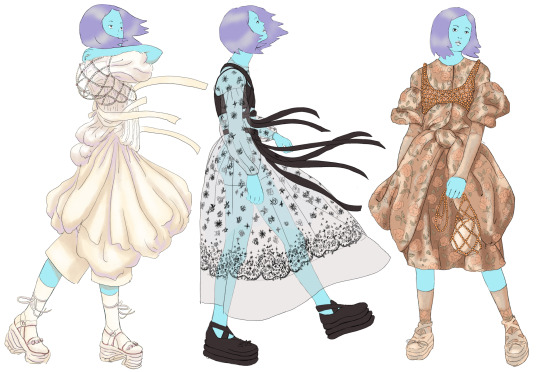



Blue Tim 12 wearing some Thom Browne, Simone Rocha, HEIHEI, Gucci and Craig Green’s clothes.
42 notes
·
View notes
Text
« Mieux vaut mourir avec honneur que mendier en vie. »
Baudouin de Toulouse, compagnon d'armes de Simon de Montfort

16 notes
·
View notes
Text
TOP 13 FAVORITE COUPLES (PART II)
07º Lise x Colas (La Fille Mal Gardee, 1789)
Status: Canon and adorable.

La Fille Mal Gardée (French for "The Poorly Guarded Girl" and sometimes called "The Girl Who Needed Watching" ) is a comic country ballet inspired by Pierre-Antoine Baudouin's 1789 painting, La Réprimande. The ballet was originally choreographed by the Ballet Master Jean Dauberval to music based on fifty-five popular French airs, and premiered in 1789 in Bordeaux, France. It's been revived multiple times and is one of the oldest ballets, kept alive due to these multiple revivals.
The story starts with Lise, a peasant girl, and her fiancé Colas. Though they're in love, Lise's mother Widow Simone (usually played by a man) wants her to marry Alain, who is stupid, but very wealthy. But Widow Simone cannot keep Lise and Colas apart. At a picnic lunch with Alain, Simone, and Alain's father Thomas, the maypole and clog dancing is interrupted by a thunderstorm. Alain's umbrella carries him away. At home, Lise spins and dances. After her mother falls asleep she tries to steal her key but is unsuccessful. The crops are brought in, and Lise, home alone, thinks about Colas, and imagines being the mother of many children through mime. Colas then appears from a stack of crops. When Simone returns Lise pushes him into the bedroom to hide him, but to her horror her mother gives her her wedding dress and demands that she go into her bedroom and put it on.
Thomas, Alain, and the notary for the marriage arrive. Alain unlocks Lise's bedroom door with the key Simone gives him. Lise enters wearing her wedding dress, with Colas by her side. Insulted, Thomas tears up the marriage contract and they leave. Lise and Colas beg the Widow to agree to their marriage and she finally does. Everyone leaves happily, celebrating the love between Lise and Colas. Alain returns to the empty house looking for his umbrella. He too has a happy ending; with his umbrella.
06º Karaba and Kirikou (Kirikou and the Sorceress, 1998)
Status: Canon and fantastical.

Kirikou and the Sorceress is a 1998 French animated film, directed by Michel Ocelot, loosely based on a West African fairy tale. It tells the story of a tiny baby boy, named Kirikou, who is born in a spectacular way (all by himself, without effort of his mother nor outside help) and can speak and walk immediately after being born. After a couple of questions, he learns that a wicked sorceress, Karaba, has cursed the village and devoured all the men and boys, except his uncle, who is on his way to fight the sorceress. He tricks the sorceress, saves his uncle as well as the children of the village (twice!!), brings the water back to the dried-up spring and, among other things, discovers the sorceress' true motivations: Karaba is evil because of all the suffering she went through at the hands of men, including a very subtly implied rape. All the bad things that she allegedly had done are ultimately proved to be false. She does hate everyone, but she gets better. Despite being a baby, Kirikou asks Karaba in marriage when she pulls a Heel–Face Turn, saying that he doesn't like little girls. She doesn't accept, of course, but then her kiss turns him into a handsome young man.
05º Queen Annika x Queen Neha (The Dragon Prince, 2018)
Status: Canon majesties.

Annika and Neha were the former queens of Duren and mothers of Aanya. They were killed by Avizandum, whom they distracted in order for the mission to retrieve the heart of a Magma Titan to succeed. Annika and Neha cared deeply for their daughter Aanya and their people and were willing to travel to another kingdom to ask for help when famine plagued Duren. They were also courageous warriors and would not hesitate to sacrifice their lives so that others may live. The series is at the fourth of its pretended seven seasons, and i hope to see more flashbacks with this power couple in the future episodes.
04º Ruby and Sapphire (Steven Universe, 2013-20)
Status: Canon made of love.

The two Crystal Gems whose love formes the heroine Garnet. Ruby is a small, red Gem described by the creators as "someone who cares a lot". She often lets her anger and frustration get the best of her, and so is complemented well by her more reserved partner Sapphire. Sapphire is a small blue Gem who possess ice powers and future vision. She can often be very withdrawn and emotionally distant, and so is complemented well by her more open partner Ruby. In the Crystal Gems home planet, their classist society tried to forbid Ruby and Sapphire’s love due to Sapphire being a noble and Ruby a bodyguard supposed to serve her. But combining their forces, this red and blue couple resisted, earning a happy marriage in the end.
#steven universe#kirikou and the sorceress#la fille mal gardee#ballet#the dragon prince#fantasy#shipps#shipping#shipping history meme#tag game#tag yourself#ask game
5 notes
·
View notes
Photo

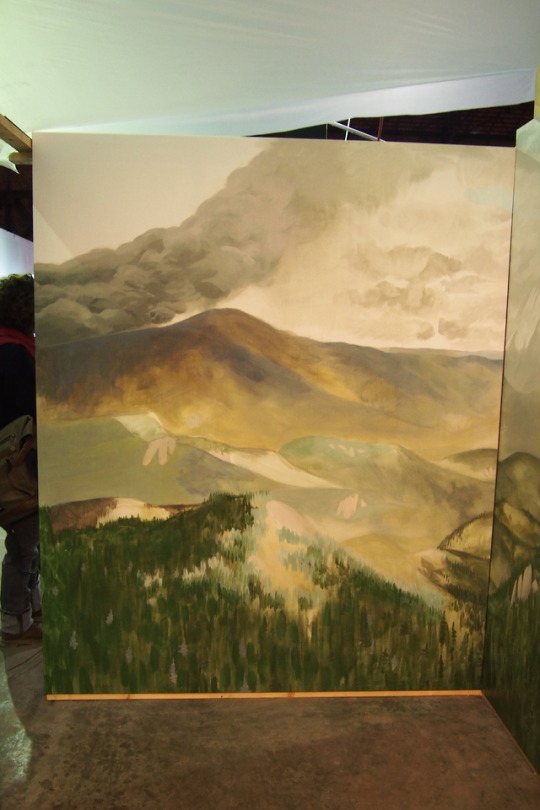
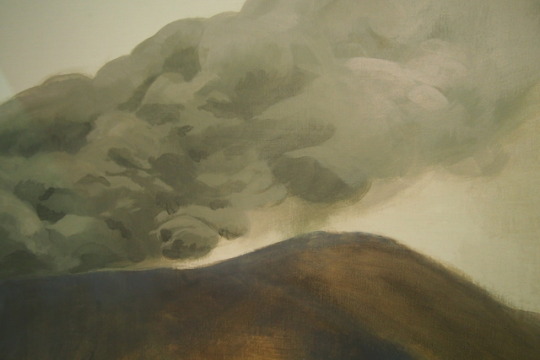


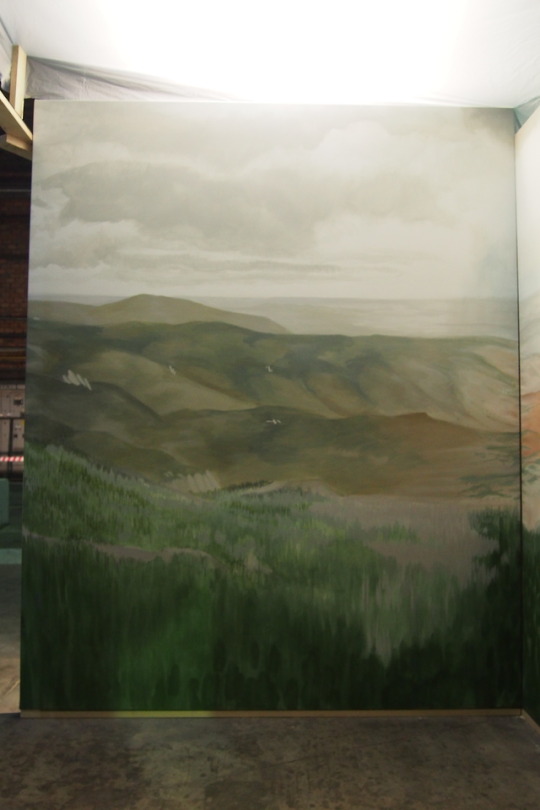
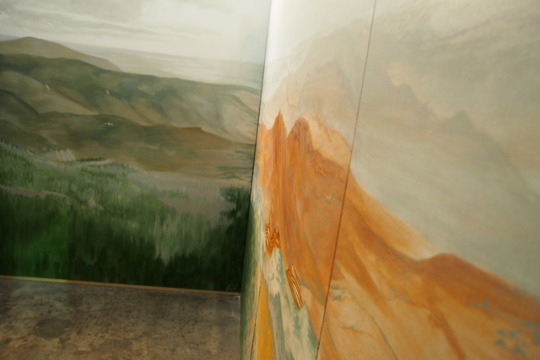


Jardinons Les Possibles
ouverture samedi 12 et dimanche 13 de 12 à 18h sur inscription
Quelques photos de la Nuit Blanche, nuit magique!
Merci à Isabelle De Maison Rouge et Ingrid Pux
et à tous les artistes qui participent :
Actions Anonymes S.A., Isabel Aguera, Ivan Argote, Rodolphe Baudouin, Pauline Bazignan, Adrien Belgrand, Emilie Benoist, Ghyslain Bertholon, Alexis Blanc, Alain Blondel, Mauro Bordin, Corine Borgnet, Matthieu Boucherit, Jean-Baptiste Boyer, Jérôme Combe, Victor Cord’homme, Gaël Davrinche, Romina de Novellis, Nicolas Dhervillers, Gérald Faro, Sara Favriau, Grégory Forstner, Jérémy Gobé, Harold Guérin, Nicolas Henry, Youcef Korichi, Yann Lacroix, Fabien Léaustic, Victor Levai, Isabelle Lévénez, Olivier Masmonteil, Philippe Mayaux, Chelsea Mortenson, Barbara Navi, Pauline Ohrel, Simon Pasieka, Laurent Pernot, Sylvain Ristori, Simon Rousset Roy, Nicolas Rubinstein, Benjamin Sabatier, Lionel Sabatté, Timothée Schelstraete, Jeanne Susplugas, Anna Ternon, Yann Toma, Clarisse Tranchard, Tristan Vyskoc, Jisoo Yoo, Cyril Zarcone
--
Jardinons Les Possibles
Curatrice Isabelle De Maison Rouge, Co-Curatrice Ingrid Pux
Les Grands Serres de Pantin
1 rue du Cheval Blanc, 93500 Pantin
5 - 19 Octobre | Nuit Blanche de Pantin
ouverture samedi 12 et dimanche 13 de 12 à 18h sur inscription
19 Octobre sur invitation
visite privée/groupée sur demande
--
Photos Gregoire Jeudy
4 notes
·
View notes
Video
vimeo
Directed by Loïc Andrieu Produced by SOLDATS FILMS Music by AGORIA (ft. STS) performing "CALL OF THE WILD" © Soldats Films © 2019 Sapiens Recordings Producer: Pierre Cazenave-Kaufman (Soldats Films) Director of photography: Simon Chaudoir Editor: Naza Giral (Soldats Films) Colorist: Mathieu Caplanne Art Director: Loïc Andrieu Los Angeles Producer Gaetan Rousseau (Paradoxal inc) Wardrobe Stylist Los Angeles: Yasmine Abraham Re-Recording Mixer: Christophe Leroy VFX House: REEPOST Starring Fleur Geffrier, Carl Crupud, Sean Roc Smith, Ron Guilbert, Christianno Chavez, Sam Ingraffia Label: Sapiens Video commissioner: Christian De Rosnay Development manager: Juliette Labrousse Production Service Los Angeles: PARADOXAL INC Sound facilities: YELLOW CAB STUDIOS ADR & Foley Mixer: Christophe Leroy Sound designers: Alexis Jung & Olivier Ranquet Foley Artist: Florian Penot Special thanks: Victoria Videnina ---------- Los Angeles crew Executive Producers: Pierre Cazenave-Kaufman (Soldats Films) Associate Producer: Gaetan Rousseau (Paradoxal Inc) Production Service Los Angeles: Paradoxal Inc Line Producer: Hugo Marcel Production Manager: Thomas Duchêne 1st AD: Manuel Roman 2nd AD: Nick Brokaw Production assistants: Eric Hellberg & Yohan Lefevre & Martin de Bokay & Nicolas Thau & Timothy Watson Vocal Coach: Laura Rizzotto Location Scout: Kaelyn Phillips Set Designer: Freyja Bardell Set decorator: Crystal Criego Prop master: Dominic Wymark Leadman: Eligh Macias Set Dresser: Daniel R. Oregel & Kevin Lopez, Pedro Ramirez, Taylor Williams Wardrobe Stylist: Yasmine Abraham Wardrobe Assistant: Coleen Chan HMU: Jessica Sainclair Casting director: Sarah-May Levy Cast: Fleur Geffrier, Carl Crupud, Sean Roc Smith, Ron Gilbert, Christianno Chavez, Sam Ingraffia, Spencer Frankeberger, Deron Cash, Rusty Rooftop, Gabriella S.Robinson, Shan Moreno, Sadyr Diouf, Natasha Churchil, Bodhi Dell, Johan Domhoff, Ryan Gatewood, Abraham Sesay Newscaster Voice Over: Douglas Rand 1st AC: Vincent Toubel 2nd AC: Dusty Saunders & Rogelio Mosqueda Steadicam Operator: Olivier Merckx Sound operator: JP Delacruz Sound design: Alexis Jung & Olivier Ranquet Mix: Christophe Leroy Gaffer: Joel Gill Best boy electric: Gerardo Ruiz Electrics: Laura Sfeir, Eddie Teram, Davis Villa, James Wray Key Grip: Dennis Pires Best Boy Grip: Ivan Garcia Grips: Robert Dulany, Ardy Fatehi, Michael Parlinic Motocrane: DRIVER’S EYE TEAM LAPD SERVICE: Paul Hinton, Darryl Martin Catering: Mia’ Cuisine Los Angeles Studios: BEEPS DINNER, SILVER DREAM FACTORY, ESCOBAR FAMILY Los Angeles Costumes rental house: UNIVERSAL COSTUME, WESTERN COSTUME Los Angeles Police Car rental house: CINEMA VEHICLES Los Angeles props rental house: ISS, SET STUFF OMEGA Los Angeles Camera rental house: PANAVISION HOLLYWOOD, CHAPMAN : LEONARD, JQ DA SILVA ---------- Paris crew Production Company: Soldats Films Producer: Pierre Cazenave (Soldats Films) Line Producer Paris: Quentin Henneguelle (Soldats Films) Production Manager: Charlotte Giral (Soldats Films) 1st AC: Maud Cyrano Gaffer: Michael Monod Electrics: Jerôme Baudouin, Cedric Guerby Key Grip: Benjamin Rame Prop Master: Ludovic Jardiné HMU: Elisabeth Pilarsky On Set VFX Supervisor: Clement Germain YELLOW CAB STUDIOS Sound designer: Alexis Jung & Olivier Ranquet Foley Artist: Florian Penot ADR & Foley Mixer: Christophe Leroy SOLDATS CREW Post Producer: Naza Giral (Soldats Films) After Effects by: Naza Giral (Soldats Films) - Rémi Muzzupapa (Soldats Films) – Paul Laurent (Soldats Films) - Victor Sellier (Soldats Films) REEPOST CREW REEPOST VFX Supervisor: Adrien LEPINEAU REEPOST VFX Post-producer: Loundja OUSSANA Assistant post-production: Tilou MARTIN 3D Supervisor: Stephen PLONGEON 3D Artists: Xavier VERDIER Marion GUICHENUY Geoffrey PONS Olivier MASSON Compositing: Matthieu DESTRADE Marc LATIL Benoit MESSAGER Johan ROCHE Gaetan BAILLEUL Thierry BONNEAU Mathieu PLESSIS Alexis BAILLA Tracking: Toufik MEKBEL Walid BEN HEND (VISION AGE VFX) Studio La Villette: Navarro ------------------ Special thanks to Agoria « You made it happen ! » Christophe Leroy for Yellow Cabs Studio « Sound Wizard ! »
2 notes
·
View notes
Link
Ses traces se sont estompées, mais l’entité créée par Godefroy de Bouillon s’est enraciné en Terre sainte pendant près de deux siècles, de 1099 à 1291.

Le Figaro a arpenté au Liban, en Jordanie et à Chypre les forteresses déchiquetées des croisés. Il est parti à Jérusalem et à Saint-Jean-d’Acre sur les traces d’un monde englouti. À la fin du XIe siècle et durant près de deux cents ans, des Occidentaux ont vécu, après la conquête de la ville sainte de Jérusalem, dans un étrange domaine d’Orient baptisé «le royaume latin de Jérusalem».
Correspondant à Jérusalem
Dans l’atrium du Saint-Sépulcre, deux jeunes femmes couvertes d’un voile s’agglutinent devant la pierre de l’onction, le lieu, pour les orthodoxes, où le corps du Christ aurait été lavé avant sa mise au tombeau. Les pèlerines, venues de Corée du Sud, se prosternent, touchent de la paume et embrassent le marbre rose. Puis elles frottent énergiquement contre la relique leur téléphone portable qui a tant servi pour les selfies pris sur les stations du chemin de croix de la Via Dolorosa.
Le circuit guidé peut commencer. Elles se dirigent dans le brouhaha à droite vers la vitrine de la chapelle d’Adam éclairée par deux lanternes. Les visiteuses se sont assises dans la pénombre sur des banquettes en forme de dalle pour découvrir un morceau du rocher du Golgotha, le lieu de la crucifixion, encastré dans un mur. Elles ignorent qu’elles se relaxent sur les tombes de Godefroy de Bouillon et de Baudouin Ier dont, confient-elles dans un fou rire, elles «n’ont jamais entendu parler». Le fondateur du royaume latin de Jérusalem et son premier roi reposent là dans l’anonymat. Violées par les envahisseurs turcs au XIIe siècle, les tombes ont perdu leurs épitaphes depuis des lustres.
Fluctuante, la mémoire du royaume latin de Jérusalem irrigue la Ville sainte mais n’apparaît souvent qu’ici ou là, au détour d’une pierre ou au fond d’un puits
En 1806, Chateaubriand avait été le dernier voyageur à déchiffrer les inscriptions latines avant l’incendie du site, deux ans plus tard. «Outre ses deux tombeaux, on en voit quatre autres à moitié brisés. Sur un de ces tombeaux, on lit encore mais avec beaucoup de peine», notait-il dans Itinéraire de Paris à Jérusalem, le récit de son périple en Terre sainte qui avait relancé au XIXe l’attrait pour la Ville sainte. L’ordonnancement décrit par l’écrivain a disparu lors du réaménagement en plusieurs chapelles après le sinistre. Les restaurateurs grecs orthodoxes étaient peu portés sur le culte, voire le respect de personnages symbolisant pour les chrétiens d’Orient une domination croisée dont ils firent après leur départ longtemps les frais. «Ils ont changé l’emplacement et enlevé les inscriptions», précise l’historien Georges Hintlian.
Fluctuante, la mémoire du royaume latin de Jérusalem irrigue la Ville sainte mais n’apparaît souvent qu’ici ou là, au détour d’une pierre ou au fond d’un puits. Il en va des hommes comme des bâtiments. La quête d’une trace du palais royal s’apparente ainsi à un rébus. La résidence bâtie près de la Tour de David, à l’entrée de l’actuelle porte de Jaffa, a disparu, mais il subsisterait un morceau de ruine apparente dans les jardins voisins de patriarcat arménien.
Le gardien du monastère Saint-Jacques, où réside le patriarche, n’en a jamais entendu parler. Son vis-à-vis, le gardien du séminaire arménien, non plus. Autant rebrousser chemin et rentrer bredouille. La rencontre fortuite sur le trottoir de l’historien arménien Georges Hintlian permet finalement de résoudre l’énigme. «C’est difficile de parler de restes visibles. Il y a dans le jardin du séminaire un vieux puits très profond avec tout en bas une croix de Jérusalem et beaucoup de scorpions, indique-t-il. Le palais latin se situait bien ici sous nos pieds, tout comme le palais d’Hérode, dont une partie est enfouie sous le poste de police.»
En quête d’un territoire englouti
Chercher les vestiges des croisés dans la Vieille Ville de Jérusalem, c’est partir en quête d’un territoire englouti par une histoire tourmentée. À l’aune d’un millénaire, l’empreinte occidentale n’avait pourtant rien d’éphémère. Le royaume latin de Jérusalem s’est enraciné en Terre sainte et a perduré pendant près de deux siècles, de 1099 à 1291. Cet État à nul autre pareil a été le premier essai d’instauration d’une société européenne en terre étrangère. Il a donné naissance, en plein Moyen Âge, à des royaumes surgis du désert dont Jérusalem était la capitale.
Les Francs se taillèrent des fiefs dans des contrées qu’ils n’avaient connues qu’en songe, à Édesse, Antioche, Tripoli, à Saint-Jean-d’Acre et sur l’île de Chypre. Les fondateurs de l’État latin d’Orient étaient des guerriers et des bâtisseurs. Ils ont érigé des lois fondamentales et des institutions en perpétuelle évolution. Ils ont créé un nouveau monde inspiré de l’ancien, une société combattante avec ses aristocrates, ses bourgeois et son petit peuple. Le flot perpétuel des nouveaux arrivants alimenté par six appels à la croisade mêlait son sang aux natifs, les Occidentaux qui avaient pris racine en Orient.
Godefroy de Bouillon est à la fois Dieu et César, ou, plus modestement, moine et chevalier
Mais revenons à Godefroy de Bouillon et Baudouin Ier. Les deux hommes sont au premier rang des assaillants qui s’emparent de la Ville sainte le 15 juillet 1099, en massacrant ses musulmans et ses juifs. Les deux hommes se partagent un pouvoir bicéphale. Godefroy de Bouillon refuse la couronne d’or et lui préfère le titre d’avoué du Saint-Sépulcre où se décide l’identité du nouveau royaume, tandis que Baudouin est nommé roi par ses pairs, les barons qui forment par le jeu des fidélités personnelles l’ossature du régime. Godefroy de Bouillon est à la fois Dieu et César, ou, plus modestement, moine et chevalier. Le fondateur de l’État franc redistribue à son arrivée des rentes aux nobles, s’empare de terres, mais il est d’abord le gardien du saint des saints, le tombeau présumé de Jésus dont la conquête est le but de la première croisade.
Le royaume ne sera pas une théocratie dirigée par le Saint-Siège comme le souhaitait le pape. Son patriarche est vite réduit à y jouer un rôle subalterne. La couronne devient héréditaire, bien que les aristocrates conservent le privilège d’élire le roi qui impose peu à peu son pouvoir. La population d’origine, qui constitue la majorité des habitants, est confinée en règle générale dans les campagnes, à l’exception des chrétiens d’Orient, traités avec bienveillance. «L’originalité du régime franc vient en partie de l’introduction au Moyen-Orient de traditions et institutions européennes, mais il apporte une touche originale en faisant intervenir le facteur religieux. C’était essentiellement sur l’appartenance religieuse que se fondait la distinction entre vainqueurs et vaincus», écrit l’historien israélien Joshua Prawer dans son Histoire du Royaume latin de Jérusalem, l’ouvrage de référence sur la période des croisades (CNRS Éditions).
Une dimension colonialiste
Dans les années 1950 et 1960, Joshua Prawer a renouvelé le regard sur un sujet abordé jusque-là par des historiens qui s’identifiaient à l’aventure vertigineuse des croisés ou développaient une conception d’un féodalisme figé. Il a restitué dans sa somme, qui se lit comme un roman d’aventures, une société en mouvement. Certaines de ses thèses sont controversées. Selon Joshua Prawer, la dimension colonialiste du projet est à l’origine de sa perte. Il estime également que le manque de bras a précipité sa disparition.
Effectué dans les années qui ont suivi la création d’Israël, son travail est marqué par les analogies avec le sionisme. L’expérience de l’État latin est comparée en creux avec l’État hébreu fondé pour une population qui ne représentait que 10 % des habitants au début du siècle dernier. «La différence est que les juifs colonisaient et travaillaient la terre alors que les croisés régnaient sur un pays conquis exploité par la population locale», explique Joshua Prawer.
«L’effondrement du royaume tient plus à des causes géopolitiques, comme les invasions mongoles»
Simon Dorso, chercheur associé au CRFJ
L’intensification des fouilles archéologiques au cours des quarante dernières années et la multiplication des versions originales de textes en arabe ont depuis sensiblement modifié les perceptions. Les chercheurs disposent de trente fois plus de données qu’à l’époque de la sortie du livre de l’historien israélien. Et de nouveaux domaines d’exploration ont émergé, comme l’étude des campagnes. «Prawer projette une partie de sa vie dans ses interprétations. Il explique l’échec de la présence latine par l’incapacité des Francs à s’attacher au pays et à y faire suffisamment d’enfants», commente Simon Dorso, chercheur associé au CRFJ (Centre de recherche français de Jérusalem).
«Son angoisse démographique est celle qui existait en Israël à sa création, ajoute le médiéviste. L’effondrement du royaume tient plus à des causes géopolitiques, comme les invasions mongoles, qui constituent un changement de paradigme: Louis IX veut s’allier avec eux, mais ils ne lui répondent même pas car ils ne savent pas qui il est. En Égypte, personne n’a vu venir le soulèvement des mamelouks. En Europe, de nouveaux espaces s’ouvrent face auxquels l’Orient a moins à offrir.»
Le Sépulcre de Marie, au pied du mont des Oliviers, à l’endroit où, selon la tradition, la mère de Jésus se serait endormie d’un sommeil éternel. - Crédits photo : Magali Cohen / Hans Lucas
Quelles que soient les raisons de sa chute, le royaume n’en compta pas moins dix-huit souverains. Treize rois et cinq reines. L’une d’elles, la reine Mélisende, repose dans le Sépulcre de Marie, au pied du mont des Oliviers, à l’endroit où, selon la tradition, la mère de Jésus se serait endormie d’un sommeil éternel. L’endroit est peu fréquenté. Héritière du trône, Mélisende avait épousé le comte Foulques d’Anjou et fut, dit-on, la maîtresse du comte de Jaffa, un ennemi de son mari de roi.
Le règne du couple royal fut une parenthèse de calme et de prospérité dans un royaume à l’apogée de sa puissance. «Mélisende a joué un rôle majeur dans la restauration du Saint-Sépulcre mais a été inhumée avec les reines qui étaient souvent d’origine arménienne», indique Georges Hintlian. Elle repose dans une minuscule chapelle au bord de l’escalier monumental qui dégringole vers la crypte mariale, vestige de l’église byzantine démolie par les Perses, relevée par les croisés et abattue par Saladin. À Jérusalem, l’histoire est un éternel recommencement.
Chronologie:
1099 - Conquête de Jérusalem par les croisés et fondation du royaume latin de Jérusalem.
1187 - Saladin prend Jérusalem aux Francs. Naissance du deuxième royaume latin de Jérusalem.
1192 - Richard Cœur de Lion et Saladin signent un traité de paix donnant accès aux pèlerins et marchands chrétiens à la Ville sainte.
1291 - Les mamelouks du sultan Baybars s’emparent de Saint-Jean-d’Acre. Le royaume latin de Jérusalem disparaît.
#godefroy de bouillon#jerusalem#moyen-orient#les royaumes latins d'orient#le royaume latin de jérusalem
2 notes
·
View notes
Text
Famous Five Art Nostalgia – Publishing Overview
Introductory post
When I started this series of posts a few months ago, I only had the vaguest idea about the various editions of the Famous Five books that existed over the years in France. The most well-known editions are those from the “Bibliothèque Rose” collection from publisher Hachette – ask anyone on the street (born in the last millennium) and it is probably what they have in mind. But through my searches on the second-hand market – both physical and online – I discovered several additional publications, and even the “Bibliothèque Rose” collection itself saw several variations over the years, giving us a plethora of cover art and inside illustrations to enjoy. Read on to get an overview of the publishing history of the Famous Five books in France (and French-speaking Switzerland)!
The French publisher, Hachette, was founded in 1826 by Louis Hachette as a bookshop and publishing company, first specialising in schoolbooks. In the 1850s, Louis Hachette opened several bookshops in railway stations and started to diversify his offer with serialised novels, travel books and magazines. In 1853, he signed a partnership with the Countess of Ségur (still famous to this day in the world of children’s literature) and subsequently founded the “Bibliothèque Rose” collection (lit. “pink library”) three years later, focused on books aimed to children aged 6-12. 150 years later, Hachette is now the first publishing company in France, and the “Bibliothèque Rose” collection still exists, although it has known many changes over the years.
The first Famous Five book was first published in France in 1955, under the simple title “Le Club des Cinq.” The French publisher did not follow the original English publishing order, and instead chose to publish in priority the books which, I assume, were deemed to garner most traction at the time. The first six books published in France have their original editions in a collection named “Ségur-Fleuriot” (thus named as an homage to two female writers whom Louis Hachette had been working with). These books were pocket-sized, with a hard cover, black-and-white illustrations, and a full-colour dust jacket.

“Ségur-Fleuriot” collection – From left to right:
#02 Five Go Adventuring Again / Le Club des Cinq (1955, ill. Simone Baudouin);
#03 Five Run Away Together / Le Club des Cinq contre-attaque (1955, ill. S. Baudouin);
#04 Five Go to Smuggler’s Top / Le Club des Cinq en vacances (1956, ill. S. Baudouin);
#06 Five Go On Kirrin Island Again / Le Club des Cinq joue et gagne (1956, ill. S. Baudouin);
#07 Five Go Off to Camp / Le Club des Cinq va camper (1957, ill. Paul Durand);
#08 Five Get into Trouble / Le Club des Cinq en péril (1957, ill. S. Baudouin).
(Note: The numbers starting with # correspond to the original English publishing order.)
From what I can gather – even if I find it odd because it doesn’t sound commercially sound – the next books benefitted from a double first edition: one in a collection called “Nouvelle Collection Ségur” with a soft cover, and the other in the above-mentioned “Bibliothèque Rose” with a hard cover. As far as I know, both these editions featured the same inside illustrations, although I have never seen a copy of a “Nouvelle Collection Ségur” book, so I cannot be absolutely sure of this. The red-coloured artwork featuring on the “Nouvelle Collection Ségur” covers were re-used (in black) on the inside title pages of the “Bibliothèque Rose” editions.

“Nouvelle Collection Ségur” – From left to right (in addition to the first six books which joined this collection at some point):
#10 Five on a Hike Together / Le Club des Cinq en randonnée (1958, ill. S. Baudouin);
#12 Five Go Down to the Sea / Le Club des Cinq au bord de la mer (1959, ill. Aldo de Amicis);
#09 Five Fall into Adventure / Le Club des Cinq et les gitans (1960, ill. Jeanne Hives);
#11 Five Have a Wonderful Time / Le Club des Cinq en roulotte (1960, ill. J. Hives);
#13 Five Go to Mystery Moor / La locomotive du Club des Cinq (1961, ill. J. Hives);
#14 Five Have Plenty of Fun / Enlèvement au Club des Cinq (1961, ill. J. Hives);
#16 Five Go to Billycock Hill / Le Club des Cinq et les papillons (1962, ill. J. Hives);
#01 Five on a Treasure Island / Le Club des Cinq et le trésor de l’île (1962, ill. J. Hives);
#18 Five on Finniston Farm / Le Club des Cinq et le coffre aux merveilles (1962, ill. J. Hives);
#19 Five Go To Demon’s Rocks / La boussole du Club des Cinq (1963, ill. J. Hives);
#17 Five Get into a Fix / Le Club des Cinq aux sports d’hiver (1964, ill. J. Hives);
#05 Five Go Off in a Caravan / Le Club des Cinq et les saltimbanques (1965, ill. J. Hives) [not featured];
#20 Five Have a Mystery to Solve / Le Club des Cinq et le vieux puits (1966, ill. J. Hives) [not featured];
#21 Five Are Together Again / Le Club des Cinq en embuscade (1967, ill. J. Hives).
If you count carefully, the 6 books from the “Ségur-Fleuriot” edition added to the 14 books from “Nouvelle Collection Ségur” make for a total of 20… out of 21 from the original English series! Where is the last book?? Well, the missing book (namely #15 Five on a Secret Trail / Le Club des Cinq se distingue) benefitted from a higher-end edition called “Idéal-Bibliothèque,” featuring a larger-size format, hard cover, better-quality paper, a dust jacket, and more numerous illustrations. A second book joined this upgraded edition a year later.

“Idéal-Bibliothèque” collection:
#15 Five on a Secret Trail / Le Club des Cinq se distingue (1961, ill. J. Hives);
#08 Five Get into Trouble / Le Club des Cinq en péril (1962, ill. J. Hives).
The “Bibliothèque Rose” editions, featuring hard covers, 4 to 6 full-page colour art, and several black and white illustrations, are the most well-known to this day.
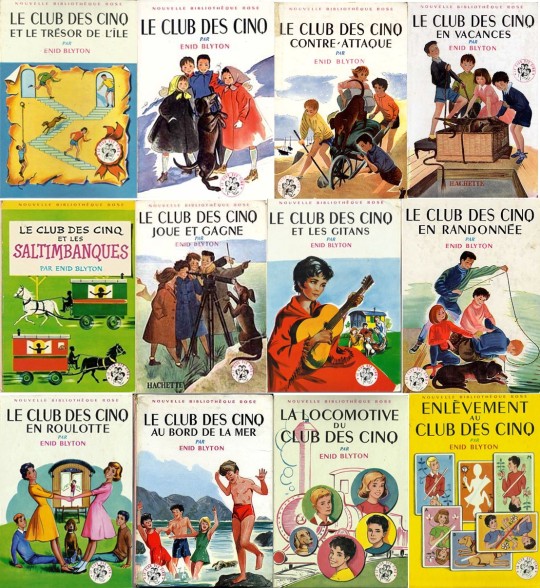
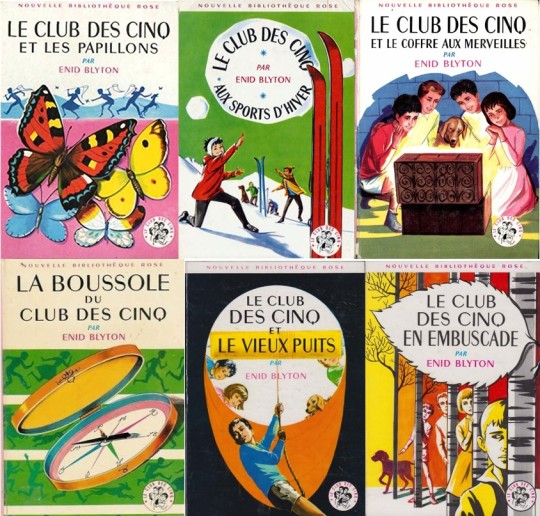
“Bibliothèque Rose” original editions from 1958 to 1967, featuring artwork from the four original illustrators
(Note: Covers sorted according to the original English publication order, as it is very difficult to pinpoint the exact French publishing order due to the many re-editions.)
The series became wildly popular and benefitted from several re-editions, some of them with new cover art produced by the then-current illustrator, Jeanne Hives.

Some “Bibliothèque Rose” re-editions from 1965-1969, featuring new cover art by Jeanne Hives
The 1970s saw a renewal of the “Bibliothèque Rose” collection with the arrival of illustrator Jean Sidobre who, over the next 15 years, produced numerous covers for all 21 books and, in time, produced the full set of inside illustrations. In these newer editions though, the number of full-page colour illustrations was reduced to four due to economic constraints.



Various cover art by Jean Sidobre from 1971 to 1985
(Note: The third cover for '#03 Five Run Away Together / Le Club des Cinq contre-attaque' is not from Sidobre but from another illustrator, called Annie-Claude Martin.)
Back in the early 1970s, thanks to the series’ popularity, some of the books were published in a larger size format featuring several more colour illustrations and some black and white ones. These editions were respectively called “Galaxie” and “Vermeille” and were both illustrated by Jean Sidobre. Some of the art is the same as in “Bibliothèque Rose” above, and some is new. You will notice that the two books from the “Galaxie” edition are also part of the “Vermeille” edition; my guess is that they started these upgraded editions as “Galaxie”, but for some reason decided that “Vermeille” was better, and so they fitted the first two books into the developing new collection – as far as I can figure out, the contents of these two books are the same under “Galaxie” and “Vermeille”, the only difference being the cover art.

“Galaxie” collection:
#02 Five Go Adventuring Again / Le Club des Cinq (1971, ill. J. Sidobre);
#21 Five Are Together Again / Le Club des Cinq en embuscade (1972, ill. J. Sidobre).

“Vermeille” collection:
#18 Five on Finniston Farm / Le Club des Cinq et le coffre aux merveilles (1973, ill. J. Sidobre);
#21 Five Are Together Again / Le Club des Cinq en embuscade (1974, ill. J. Sidobre);
#02 Five Go Adventuring Again / Le Club des Cinq (1974, ill. J. Sidobre);
#01 Five on a Treasure Island / Le Club des Cinq et le trésor de l’île (1975, ill. J. Sidobre);
#17 Five Get into a Fix / Le Club des Cinq aux sports d’hiver (1975, ill. J. Sidobre);
#09 Five Fall into Adventure / Le Club des Cinq et les gitans (1975, ill. J. Sidobre);
#04 Five Go to Smuggler’s Top / Le Club des Cinq en vacances (1975, ill. J. Sidobre).
The 1980s saw a drop in “Bibliothèque Rose” sales as kids were moving from books to TV and video games. To boost sales, the publisher made several changes to the look and format of the books, and the original text was sometimes abridged.
In 1988, as sales continued to fall, and to save money, Hachette changed its “Bibliothèque Rose” hardbacks to a softcover pocket format. The inside colour illustrations disappeared and the black and white ones decreased in number (re-using former art from Sidobre). On the upside, these editions saw a series of new cover art from a different illustrator, Yves Beaujard, whose art style on these covers is very similar to Sidobre’s, which leads me to think that this was a requirement from the publisher who wanted a certain consistency between Beaujard’s cover art and Sidobre’s inside illustrations.
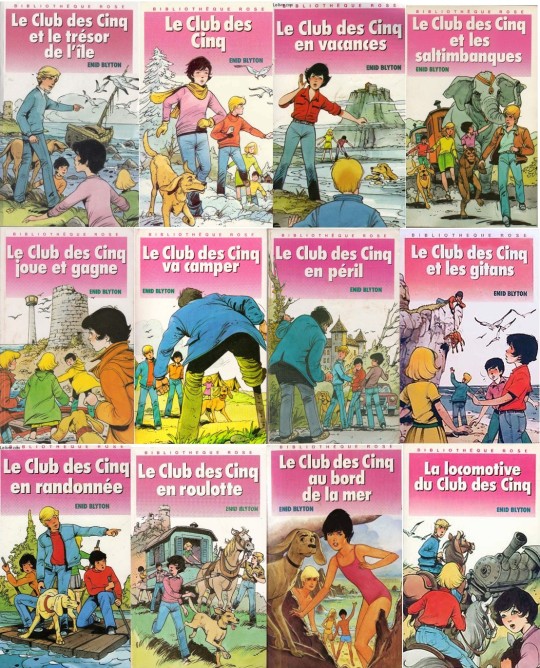

From 1988 to 1992, the whole series benefitted from new cover art by Yves Beaujard (with the exception of ‘Le Club des Cinq au bord de la mer’ and ‘Le Club des Cinq et les papillons’, which re-used former art from Jean Sidobre)
(Note: As far as I know, ‘#03 Five Run Away Together / Le Club des Cinq contre-attaque’ was never included in this edition.)
In the 1990s, a series of new cover art was produced by Paul Gillon, with the same general layout as the previous edition. The inside black and white illustrations are either former art by Sidobre or new art by Anne Bozellec.
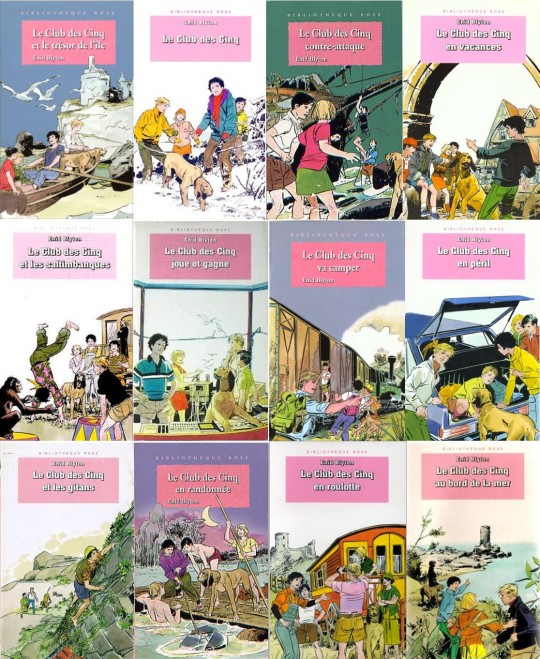

Cover art by Paul Gillon from 1991-98
In 2000, Hachette celebrated the new millennium with a new style for its “Bibliothèque Rose” collection, featuring a hybrid format between hardback and softback adorned with a glossy aesthetic. The inside illustrations are the same as the previous editions, by Sidobre or Bozellec.

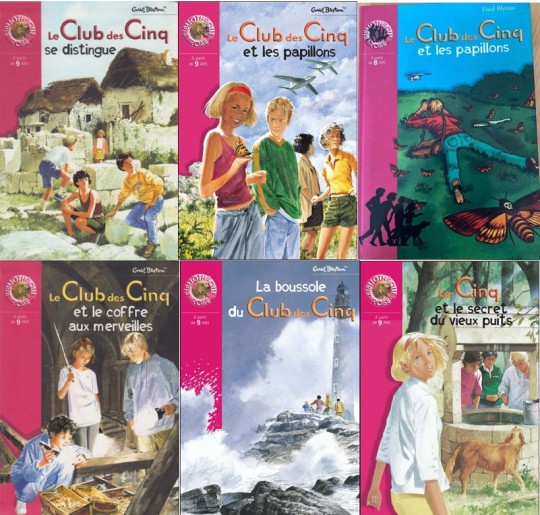
Cover art by Philippe Munch and Jame’s Prunier from 1999-2004
(Note: As far as I know, ‘#10 Five Go on a Hike Together / Le Club des Cinq en randonnée’, ‘#11 Five Have a Wonderful Time / Le Club des Cinq en roulotte’, ‘#12 Five Go Down to the Sea / Le Club des Cinq au bord de la mer’, ‘#17 Five Get into a Fix / Le Club des Cinq aux sports d’hiver’ and ‘#21 Five Are Together Again / Le Club des Cinq en embuscade’ were never included in this edition.)
In the mid-2000s, the morality police made their way through the books, resulting in watered-down translations and some title changes. Frédéric Rébéna did a series of new cover art. The inside illustrations all but disappeared, only featuring as small vignettes at the opening of each chapter.

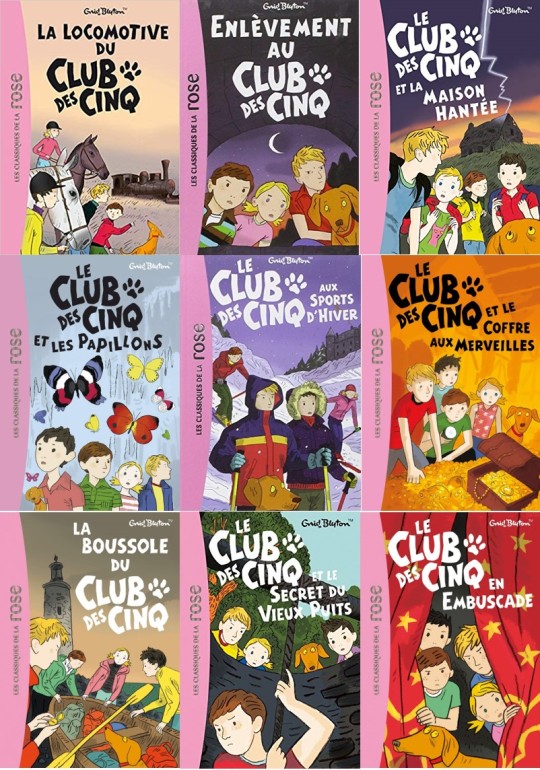
Cover art by Frédéric Rébéna from 2005-11
In the 2020s, the series changed from “Bibliothèque Rose” to “Bibliothèque Verte” collection with new cover art by Auren.
Similar to “Bibliothèque Rose,” “Bibliothèque Verte” (lit. “green library”) was another historically popular collection from publisher Hachette, initially aimed toward a teenage male readership, while “Bibliothèque Rose” was leaning toward a younger and female audience. Nowadays, the line between what is deemed appropriate reading material for boys or girls has thankfully blurred and both collections are now thematically oriented, “Bibliothèque Rose” focusing on humour/emotion and “Bibliothèque Verte” on action/adventure. Hence the marketing decision that caused the Famous Five series to lose its historical pink palette.


Cover art by Auren from 2019-21
And that’s a wrap for the main French editions! But there’s still a few more to go through.
First is France Loisirs, a book sales club to which you can register and you will receive a certain number of books each month. I do not know if the whole series was ever fully published by France Loisirs; the visuals that you will find below are all that I could find. The books are hardbacks with a dust jacket and without any inside illustrations. From what I could gather, they were published from 1975 to the early 1980s. The illustrator is called J.P. Morvan and, if you look closely, often took inspiration from earlier “Bibliothèque Rose” illustrations by Jean Sidobre.
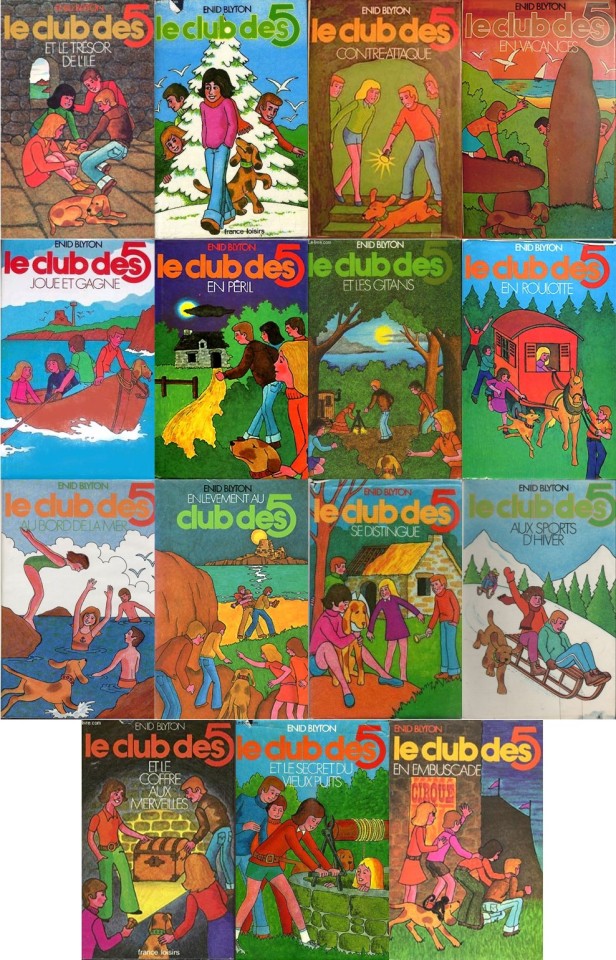
“France Loisirs” edition from 1975-82 with cover art by J.P. Morvan
In the 1990s, France Loisirs published another batch, re-using cover art by Paul Gillon from the contemporary “Bibliothèque Rose” edition. I’m a bit fuzzy on the exact dates, but these were published from the early to mid-1990s to around 2000. I do not know anything about the books themselves, but I can assume that they contain only plain text without any inside illustrations.

“France Loisirs” edition from the 1990s featuring art by Paul Gillon
Last on our exploration of “Famous Five” French publishing is actually not French at all! But I’m including it in this post because it uses the same French translations as Hachette.
This particular edition is from a publisher named “Edito Service SA, Genève”, which you may have guessed is from Switzerland. I don’t have a lot of information about its history and only learned about its existence because some of these books made it through the border into France, and from there onto the online second-hand market. The books each contain 5 illustrations by Umberto Nonna (3 black and white and 2 full-colour), and they come both in softback and hardback formats. They were published in 1981-82.
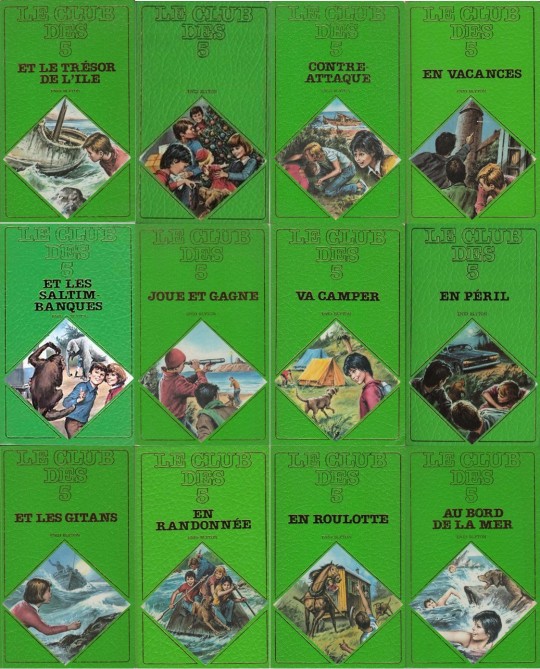

“Edito Service” edition from 1981-82 (softbacks)

“Edito Service” edition from 1981-82 (some of the hardbacks)
(Note: Despite what the above pictures suggest, all the hardback covers have the same dark green background.)
Thank you for your attention, and see you soon!
~~~~~~
We’ve now truly come to the end of this deep-dive into Famous Five French publishing.
#papillon82 reads#famous five art nostalgia#famous five#le club des cinq#illustrations#publishing overview#hachette#simone baudouin#paul durand#aldo de amicis#jeanne hives#jean sidobre#annie-claude martin#enid blyton#yves beaujard#paul gillon#anne bozellec#philippe munch#jame's prunier#frédéric rébéna#auren#jp morvan#umberto nonna#whew this post was a long time coming!#I have another post ready to go but I'd like to have more of a buffer before I resume my posting schedule#hopefully our regular posting schedule will resume next Sunday#until then have a great week!
8 notes
·
View notes
Text
Les p’tits trips #1 - Paris
Petits voyages dans l’hexagone, le nez au vent, Minolta XE-1 en bandoulière.
Ahhh, Paris, que j’aime de plus en plus découvrir au fur et à mesure de mes passages.
Il m’a fallu du temps pour apprécier Paris.
Au début j’en disai, pour résumer, « c’est gris, c’est moche ». Un peu hâtif comme jugement, je vous l’accorde. Même si j’avais tout de suite accroché avec Montmartre (le syndrome « Amélie Poulain » sans doute), le Père Lachaise (Jim Morrison, ma jeunesse, tout ça…) et les ponts (j’ai un truc avec les ponts…)
Puis à force d’y retourner, de m’y balader au hasard en écoutant Emilie Simon chanter son amour pour elle, je suis tomber amoureux aussi, de la capitale.

Quand “je monte à Paris”, je suis dans le 11ème, dans une rue très animée, d’un quartier très animé. Et ce qui m’a fait aimé Paris, c’est que cette ville est d’une richesse inouïe pour qui prend simplement le temps de regarder.
Et prendre le temps, ça tombe bien, j’adore ça.
Les passages, les immeubles parisiens typiques, le Canal St Martin, la gare du Nord. Et le Pavillon Carré de Baudouin où j’ai pu (re)découvrir une rétrospective sur le travail de Willy Ronis et, en ce moment, une très belle exposition de William Daniels.



Même si je ne suis pas un adepte des sentiers battus, je suis aussi passé par quelques endroits bien connus que j’ai beaucoup apprécié. Et notamment une balade sous la pluie à la BNF, puis le long des quais de Seine pour remonter vers le Marais.
Je suis revenu là le lendemain pour le centre Pompidou, les Halles et les alentours que j’aime beaucoup aussi pour le côté graphique.


Et c’est tout ?
Certains quartiers déjà visités en numérique (la Butte-aux-Cailles, le parc Montsouris, la petite ceinture) méritent une nouvelle visite.
à suivre…
2 notes
·
View notes
Link
Ediçoes CN’s intern Simon Van Honacker takes over the monthly Edições CN review. He dreamt up a mix of “jonge ouders en hun kids” (recorded in Planckendael), Kempense made-up folklore (Pompoenregatta), and various musics new and old. It’s beautiful. (LYL Radio)
Tracklist: JEAN-LUC FAFCHAMPS – Z1
JULIEN SCHOENHARTS LEEST GUIDO GEZELLE – Wat Zijt Gij Toch
O.A.S.I. – Suono Giallo
JANNES SNYERS – Opname uit audioperformance in Vooruit, Gent
FIELD RECORDING – POMPOENCURLING TE KASTERLEE (October 2018)
JOERI CHIPSFINGER – Suikerspinkots Voor Het Volk
DISENO CORBUSIER & NEO ZELANDA – Untitled
FELIX BLUMÉ – Prayers, Singings and Maestro Midouin’s Saxophone Solo
DE ZOON – Bunker-opname te Llanberis Bomb Store
CHE CHEN ROBBIE LEE – This Was The Only Spot That Was Green
PAUL DEMETS – Enkeling
LICHEN ADDRESS – Golem xv
EINDE VAN EEN BINGO-AVOND in GIUSEPPE’S, GHAJNSIELEM – Malta
RADIO OP-NAMES VAN RADIO MARIA – Malta
BAUDOUIN OOSTERLYNCK – Oratorio
OPNAME TE PLANCKKENDAEL, NABIJ NEUSHOORNS
NICK STORRING – Ungulates
LIL SNEAKY VAPE – Silence
RAZEN – Raffle Of The Night No.1
1 note
·
View note
Photo

Alice au pays des merveilles adapté par Jeanne Cappe et illustré par Simone Baudouin 1966. #aliceaupaysdesmerveilles #simonebaudoin #casterman #aliceinwonderland #lewiscarroll https://www.instagram.com/p/CYOrYQhogSs/?utm_medium=tumblr
0 notes
Text
Events 7.16
622 – The beginning of the Islamic calendar.
997 – Battle of Spercheios: Bulgarian forces of Tsar Samuel are defeated by a Byzantine army under general Nikephoros Ouranos at the Spercheios River in Greece.
1054 – Three Roman legates break relations between Western and Eastern Christian Churches through the act of placing an Papal bull (of doubtful validity) of Excommunication on the altar of Hagia Sophia during Saturday afternoon divine liturgy. Historians frequently describe the event as the start of the East–West Schism.
1212 – Battle of Las Navas de Tolosa: After Pope Innocent III calls European knights to a crusade, forces of Kings Alfonso VIII of Castile, Sancho VII of Navarre, Peter II of Aragon and Afonso II of Portugal defeat those of the Berber Muslim leader Almohad, thus marking a significant turning point in the Reconquista and in the medieval history of Spain.
1228 – The canonization of Saint Francis of Assisi
1232 – The Spanish town of Arjona declares independence and names its native Muhammad ibn Yusuf as ruler. This marks the Muhammad's first rise to prominence; he would later establish the Nasrid Emirate of Granada, the last independent Muslim state in Spain.
1251 – Celebrated by the Carmelite Order–but doubted by modern historians–as the day when Saint Simon Stock had a vision of the Virgin Mary.
1377 – King Richard II of England is crowned.
1661 – The first banknotes in Europe are issued by the Swedish bank Stockholms Banco.
1683 – Manchu Qing dynasty naval forces under traitorous commander Shi Lang defeat the Kingdom of Tungning in the Battle of Penghu near the Pescadores Islands.
1769 – Father Junípero Serra founds California's first mission, Mission San Diego de Alcalá. Over the following decades, it evolves into the city of San Diego, California.
1779 – American Revolutionary War: Light infantry of the Continental Army seize a fortified British Army position in a midnight bayonet attack at the Battle of Stony Point.
1790 – The District of Columbia is established as the capital of the United States after signature of the Residence Act.
1809 – The city of La Paz, in what is today Bolivia, declares its independence from the Spanish Crown during the La Paz revolution and forms the Junta Tuitiva, the first independent government in Spanish America, led by Pedro Domingo Murillo.
1849 – Antonio María Claret y Clará founds the Congregation of the Missionary Sons of the Immaculate Heart of Mary, popularly known as the Claretians in Vic, in the province of Barcelona, Catalonia, Spain.
1858 – The last apparition of the Blessed Virgin Mary to Bernadette Soubirous in Lourdes, France.
1861 – American Civil War: At the order of President Abraham Lincoln, Union troops begin a 25-mile march into Virginia for what will become the First Battle of Bull Run, the first major land battle of the war.
1862 – American Civil War: David Farragut is promoted to rear admiral, becoming the first officer in United States Navy to hold an admiral rank.
1909 – Persian Constitutional Revolution: Mohammad Ali Shah Qajar is forced out as Shah of Persia and is replaced by his son Ahmad Shah Qajar.
1910 – John Robertson Duigan makes the first flight of the Duigan pusher biplane, the first aircraft built in Australia.
1915 – Henry James becomes a British citizen to highlight his commitment to Britain during the first World War.
1915 – At Treasure Island on the Delaware River in the United States, the First Order of the Arrow ceremony takes place and the Order of the Arrow is founded to honor American Boy Scouts who best exemplify the Scout Oath and Law.
1927 – Augusto César Sandino leads a raid on U.S. Marines and Nicaraguan Guardia Nacional that had been sent to apprehend him in the village of Ocotal, but is repulsed by one of the first dive-bombing attacks in history.
1931 – Emperor Haile Selassie signs the first constitution of Ethiopia.
1935 – The world's first parking meter is installed in Oklahoma City, Oklahoma.
1941 – Joe DiMaggio hits safely for the 56th consecutive game, a streak that still stands as an MLB record.
1942 – Holocaust: Vel' d'Hiv Roundup (Rafle du Vel' d'Hiv): The government of Vichy France orders the mass arrest of 13,152 Jews who are held at the Vélodrome d'Hiver in Paris before deportation to Auschwitz.
1945 – Manhattan Project: The Atomic Age begins when the United States successfully detonates a plutonium-based test nuclear weapon near Alamogordo, New Mexico.
1945 – World War II: The heavy cruiser USS Indianapolis leaves San Francisco with parts for the atomic bomb "Little Boy" bound for Tinian Island.
1948 – Following token resistance, the city of Nazareth, revered by Christians as the hometown of Jesus, capitulates to Israeli troops during Operation Dekel in the 1948 Arab–Israeli War.
1948 – The storming of the cockpit of the Miss Macao passenger seaplane, operated by a subsidiary of the Cathay Pacific Airways, marks the first aircraft hijacking of a commercial plane.
1950 – Chaplain–Medic massacre: American POWs are massacred by North Korean Army.
1951 – King Leopold III of Belgium abdicates in favor of his son, Baudouin I of Belgium.
1951 – J. D. Salinger publishes his popular yet controversial novel, The Catcher in the Rye.
1956 – Ringling Bros. and Barnum & Bailey Circus closes its last "Big Tent" show in Pittsburgh, Pennsylvania; due to changing economics, all subsequent circus shows will be held in arenas.
1957 – KLM Flight 844 crashes off the Schouten Islands in present day Indonesia (then Netherlands New Guinea), killing 58 people.
1965 – The Mont Blanc Tunnel linking France and Italy opens.
1965 – South Vietnamese Colonel Phạm Ngọc Thảo, a formerly undetected communist spy and double agent, is hunted down and killed by unknown individuals after being sentenced to death in absentia for a February 1965 coup attempt against Nguyễn Khánh.
1969 – Apollo program: Apollo 11, the first mission to land astronauts on the Moon, is launched from the Kennedy Space Center at Cape Kennedy, Florida.
1979 – Iraqi President Ahmed Hassan al-Bakr resigns and is replaced by Saddam Hussein.
1983 – Sikorsky S-61 disaster: A helicopter crashes off the Isles of Scilly, causing 20 fatalities.
1990 – The Luzon earthquake strikes the Philippines with an intensity of 7.7, affecting Benguet, Pangasinan, Nueva Ecija, La Union, Aurora, Bataan, Zambales and Tarlac.
1990 – The Parliament of the Ukrainian SSR declares state sovereignty over the territory of the Ukrainian SSR.
1994 – The comet Shoemaker-Levy 9 is destroyed in a head-on collision with Jupiter.
1999 – John F. Kennedy Jr., his wife, Carolyn, and her sister, Lauren Bessette, died when the Piper Saratoga PA-32R aircraft he was piloting crashed into the Atlantic Ocean off the coast of Martha's Vineyard.
2004 – Millennium Park, considered Chicago's first and most ambitious early 21st-century architectural project, is opened to the public by Mayor Richard M. Daley.
2007 – An earthquake of magnitude 6.8 and 6.6 aftershock occurs off the Niigata coast of Japan killing eight people, injuring at least 800 and damaging a nuclear power plant.
2009 – Teoh Beng Hock, an aide to a politician in Malaysia is found dead on the rooftop of a building adjacent to the offices of the Anti-Corruption Commission, sparking an inquest that gains nationwide attention.
2013 – As many as 27 children die and 25 others are hospitalized after eating lunch served at their school in eastern India.
2015 – Four U.S. Marines and one gunman die in a shooting spree targeting military installations in Chattanooga, Tennessee.
2019 – A 100-year-old building in Mumbai, India, collapses, killing at least 10 people and leaving many others trapped.
0 notes
Text
quel onze pour les Diables face à la Côte d’Ivoire?

quel onze pour les Diables face à la Côte d’Ivoire
L’équipe nationale belge aura un visage différent au coup d’envoi du match de préparation contre la Côte d’Ivoire, ce jeudi soir au stade Roi Baudouin (20h45), garni de supporters pour la première fois depuis novembre 2019.
Roberto Martinez va profiter de la première partie de son triptyque d’octobre pour effectuer de nombreux tests et ainsi donner du temps de jeu aux nouveaux venus et habituels remplaçants. Ce deuxième duel de l’histoire entre la Belgique et la Côte d’Ivoire risque donc d’être particulier. En effet, le technicien espagnol a sélectionné 33 joueurs et les 5 nouveaux, Sebastiaan Bornauw (Cologne), Joris Kayembe (Charleroi), Dodi Lukebakio (Hertha Berlin), Alexis Saelemaekers (AC Milan) et Zinho Vanheusden (Standard), pourraient tous faire leur début.
Une bonne occasion pour les jeunes
Si les jeunes ont l’occasion de saisir leur chance, c’est dû au calendrier international chargé et à l’inhabituelle rotation que devrait effectuer Martinez pour préserver les organismes. Eden Hazard blessé, les cadres de l’équipe nationale disputeront uniquement les deux matches à l’extérieur en Ligue des Nations, contre l’Angleterre à Wembley (dimanche) puis contre l’Islande à Reykjavik (mercredi). Pour l’Espagnol, cette rencontre de jeudi est “parfaite pour permettre aux jeunes joueurs d’engranger de l’expérience” et importante tant pour le classement FIFA qu’en vue de la future liste des 23 pour l’Euro.
Jeudi, les fans seront présents pour la première fois depuis le 19 novembre et une victoire 6-1 contre Chypre. La fédération a d’abord mis 11.000 tickets à disposition, dont 6.200 étaient vendus mercredi matin. Mais mercredi après-midi, l’échevin bruxellois des Sports Benoit Hellings a annoncé que le nombre de supporters autorisés à assister au match était réduit de 11.000 à 7.000 en raison des mesures prises dans le cadre de la crise sanitaire.
Ces fans auront très certainement l’occasion d’assister à l’éclosion de plusieurs jeunes. En effet, si Simon Mignolet défendra les buts et fera office de taulier, plusieurs joueurs devraient fêter leur première sous le maillot national. Bornauw et Vanheusden pourraient débuter dans l’axe central, où Dedryck Boyata et Brandon Mechele revendiquent aussi une place dans le trio défensif. Sur les flancs, tant Kayembe à gauche que Saelemaekers de l’autre côté sont candidats à une place de titulaire. Le joueur de l’AC Milan semble malgré tout partir avec une longueur de retard sur Timothy Castagne, très en vue depuis son transfert à Leicester City.
Vanaken titulaire?
Dans l’axe, Hans Vanaken et Leander Dendoncker pourraient être les dépositaires du jeu. Aux avant-postes, Michy Batshuayi et Christian Benteke sont les deux options pour occuper le front de l’attaque. Leandro Trossard, Divock Origi et Jéremy Doku, récemment transféré d’Anderlecht au Stade Rennais pour 26 millions d’euros, se disputeront les deux places sur les ailes. Initialement, les Diables devaient défier la Nouvelle-Zélande mais les Kiwis ont dû renoncer en raison de problèmes organisationnels liés aux strictes mesures sanitaires. C’est finalement la Côte d’Ivoire qui se présentera sur la route des Diables. En mars 2014, les Ivoiriens, portés par Didier Drogba, avaient accroché un partage (2-2) pour le premier duel entre les deux nations. Plus de six ans plus tard, les Éléphants n’occupent plus la même position sur l’échiquier du football mondial.
Quart-de-finaliste de la Coupe d’Afrique des Nations 2019, la Côte d’Ivoire a mal débuté ses qualifications pour la prochaine CAN, perdant en Éthiopie, en novembre 2019, son dernier match en date. Depuis lors, Patrice Beaumelle est arrivé à la tête de la sélection et veut profiter de cette rencontre pour bâtir un groupe solide en vue des prochaines échéances. C’est dans cette optique que l’entraîneur français a rappelé en sélection Gervinho et Geoffroy Serey Die.
Le onze probable
Mignolet, Vanheusden, Boyata, Bornauw – Castagne, Vanaken, Dendoncker, Saelemaekers – Trossard, Doku, Batshuayi
Auteur: 7sur7.be – 7sur7.be
Crédit: Lien source
The post quel onze pour les Diables face à la Côte d’Ivoire? appeared first on Seneweb.fr.
source https://seneweb.fr/quel-onze-pour-les-diables-face-a-la-cote-divoire/
0 notes